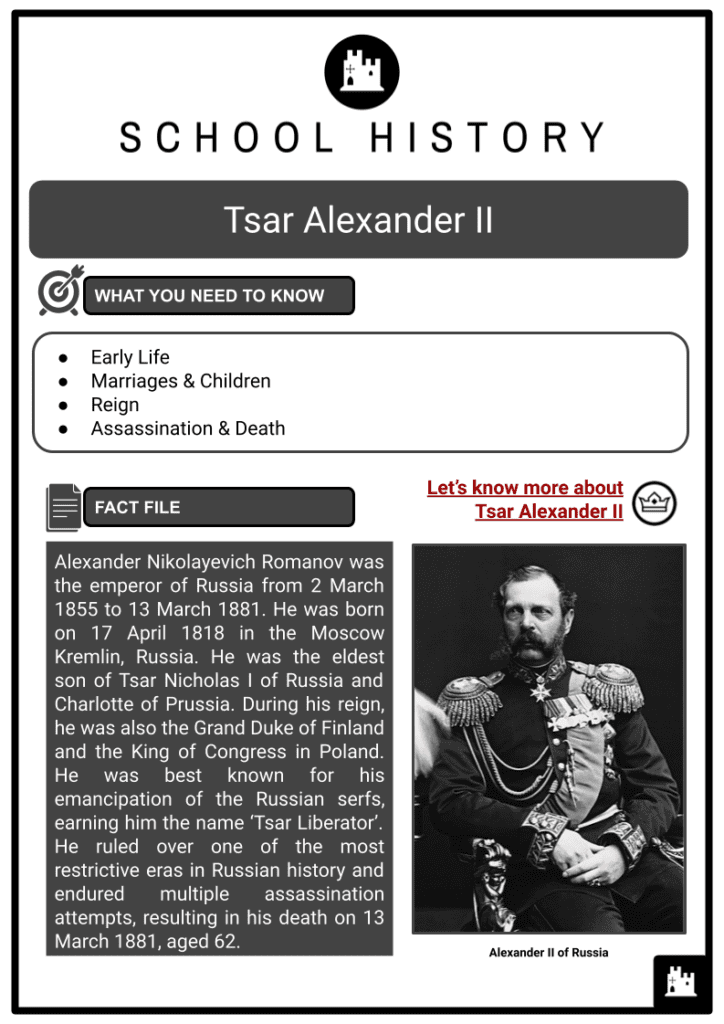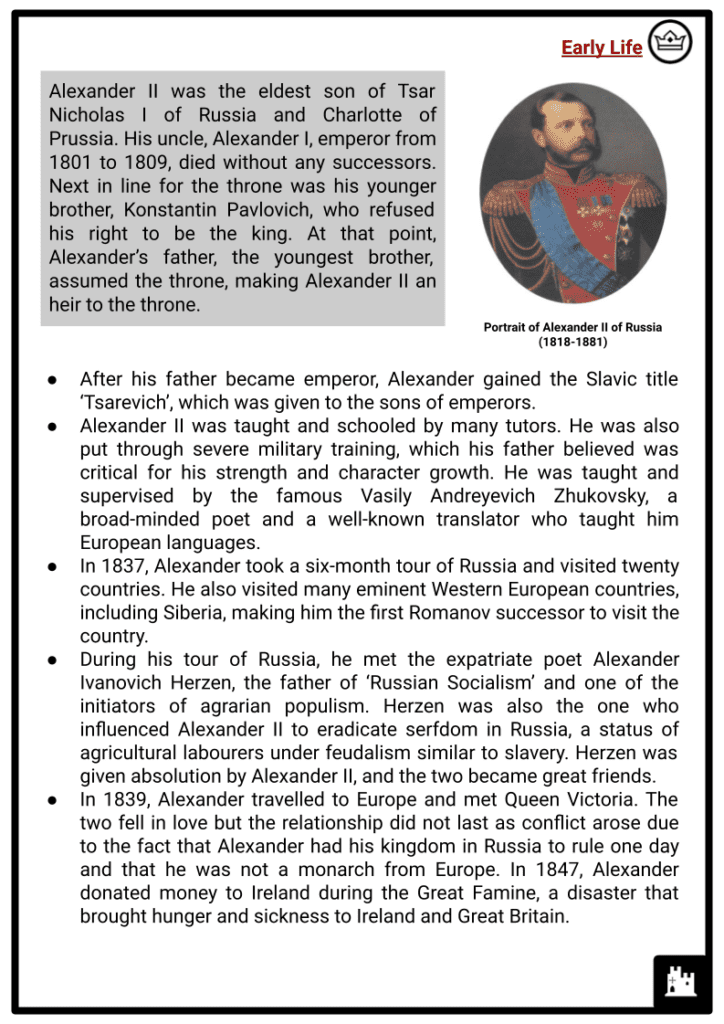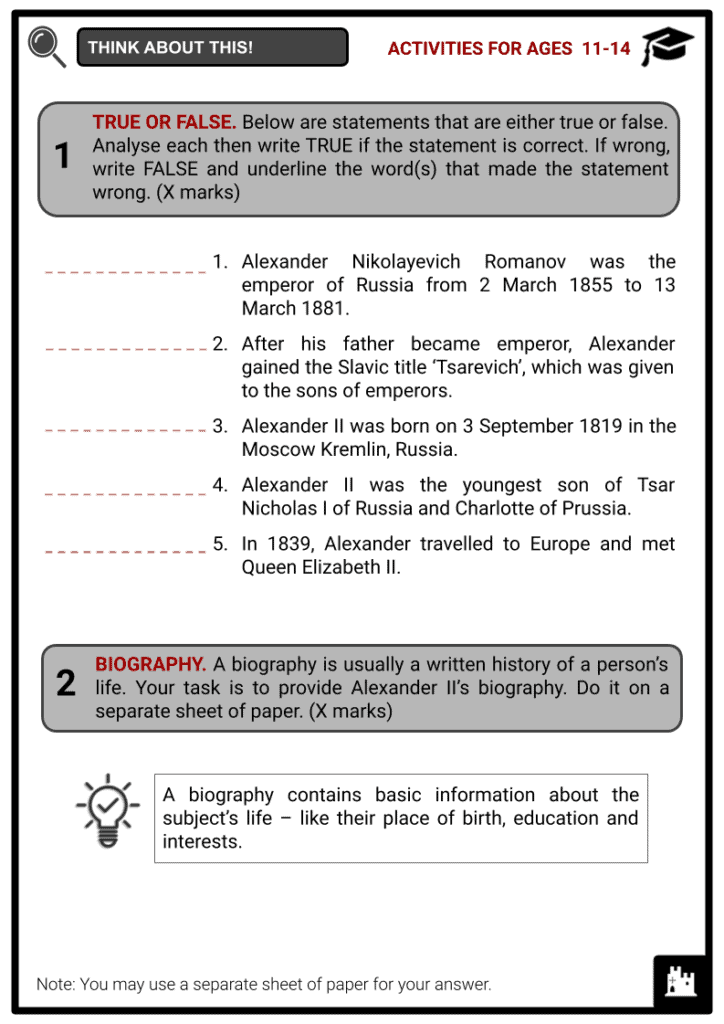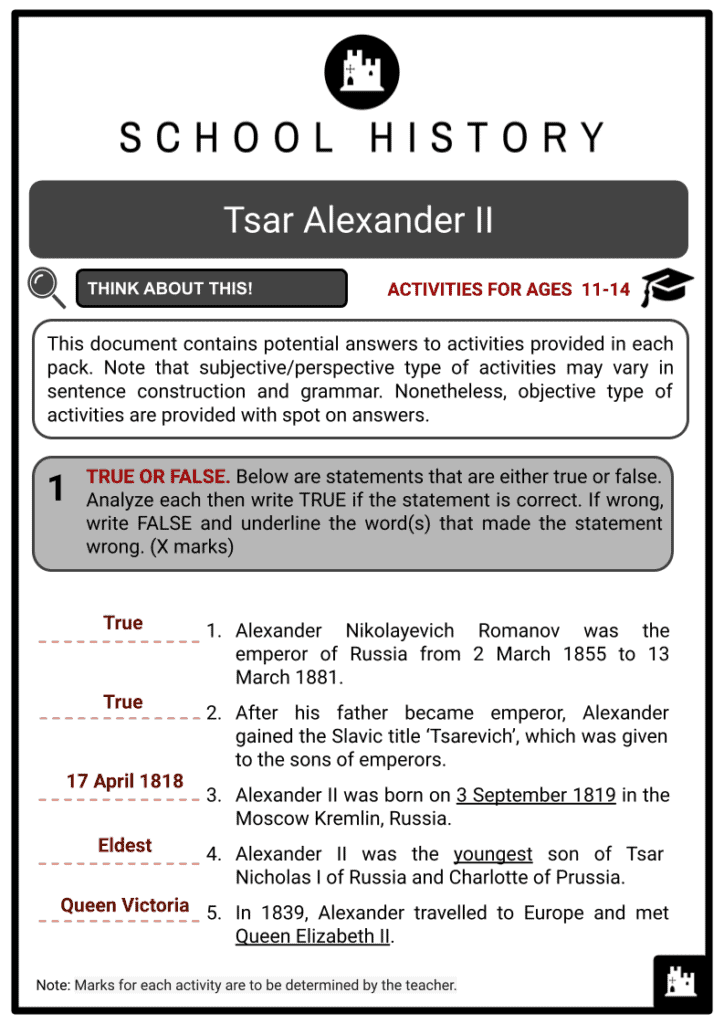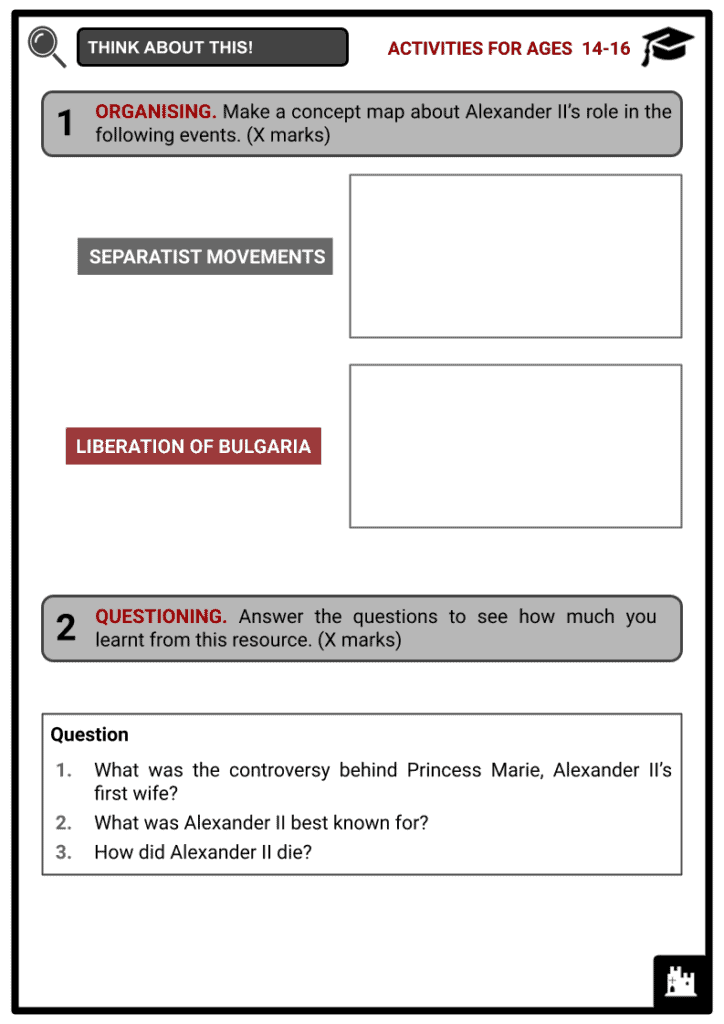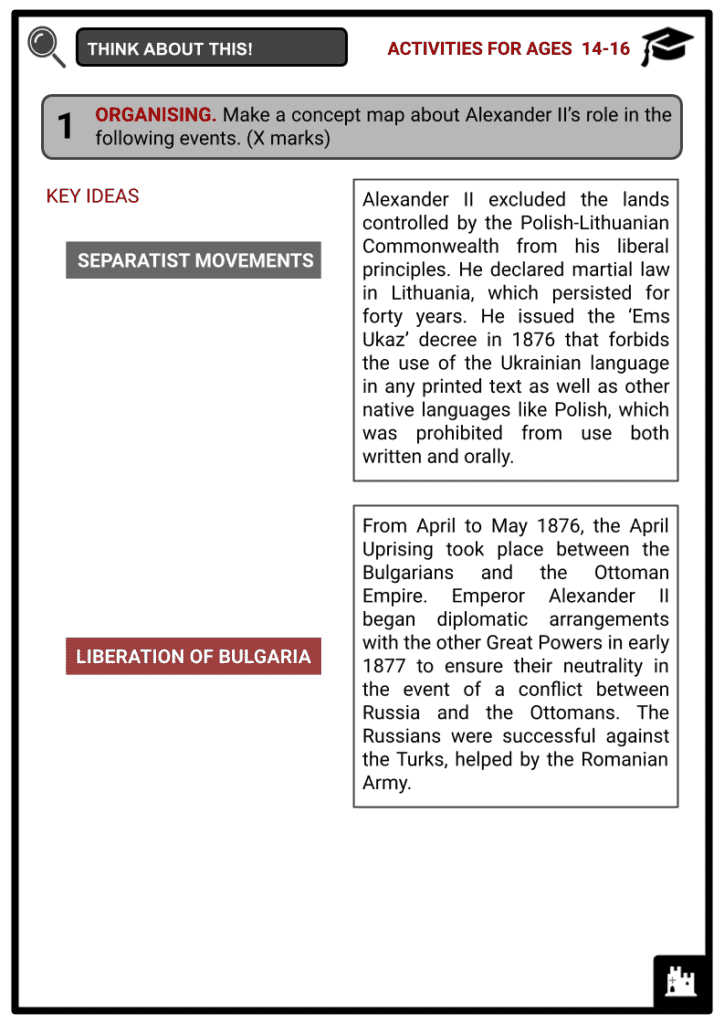Tsar Alexander II Worksheets
Do you want to save dozens of hours in time? Get your evenings and weekends back? Be able to teach about Tsar Alexander II to your students?
Our worksheet bundle includes a fact file and printable worksheets and student activities. Perfect for both the classroom and homeschooling!
Summary
- Early Life
- Marriages & Children
- Reign
- Assassination & Death
Key Facts And Information
Let’s find out more about Tsar Alexander II!
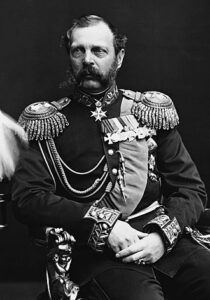
Alexander Nikolayevich Romanov was the emperor of Russia from 2 March 1855 to 13 March 1881. He was born on 17 April 1818 in the Moscow Kremlin, Russia. He was the eldest son of Tsar Nicholas I of Russia and Charlotte of Prussia. During his reign, he was also the Grand Duke of Finland and the King of Congress in Poland. He was best known for his emancipation of the Russian serfs, earning him the name ‘Tsar Liberator’. He ruled over one of the most restrictive eras in Russian history and endured multiple assassination attempts, resulting in his death on 13 March 1881, aged 62.
Early Life
- Alexander II was the eldest son of Tsar Nicholas I of Russia and Charlotte of Prussia. His uncle, Alexander I, emperor from 1801 to 1809, died without any successors. Next in line for the throne was his younger brother, Konstantin Pavlovich, who refused his right to be the king. At that point, Alexander’s father, the youngest brother, assumed the throne, making Alexander II an heir to the throne.
- After his father became emperor, Alexander gained the Slavic title ‘Tsarevich’, which was given to the sons of emperors.
- Alexander II was taught and schooled by many tutors. He was also put through severe military training, which his father believed was critical for his strength and character growth. He was taught and supervised by the famous Vasily Andreyevich Zhukovsky, a broad-minded poet and a well-known translator who taught him European languages.
- In 1837, Alexander took a six-month tour of Russia and visited twenty countries. He also visited many eminent Western European countries, including Siberia, making him the first Romanov successor to visit the country.
- During his tour of Russia, he met the expatriate poet Alexander Ivanovich Herzen, the father of ‘Russian Socialism’ and one of the initiators of agrarian populism. Herzen was also the one who influenced Alexander II to eradicate serfdom in Russia, a status of agricultural labourers under feudalism similar to slavery. Herzen was given absolution by Alexander II, and the two became great friends.
- In 1839, Alexander travelled to Europe and met Queen Victoria. The two fell in love but the relationship did not last as conflict arose due to the fact that Alexander had his kingdom in Russia to rule one day and that he was not a monarch from Europe. In 1847, Alexander donated money to Ireland during the Great Famine, a disaster that brought hunger and sickness to Ireland and Great Britain.
Marriages & Children
- From 1838 to 1839, Alexander II made his traditional trip through Europe known as the Grand Tour. It was a peregrination that only the young, male, European aristocrats took when they had come of age. One of the goals of the journey was for him to find a suitable spouse. His father, Nicholas I, proposed to Princess Alexandrine of Baden, but Alexander was given the freedom to select his wife upon the condition that she was not from the lower class or a Roman Catholic.
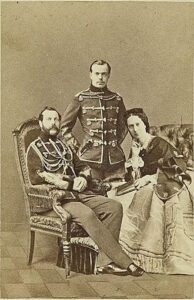
Emperor Alexander II and his wife, Empress Maria, with their son, Alexander III Emperor Alexander II and his wife, Empress Maria, with their son, Alexander III
First Marriage
- During his tour in Germany, he unintentionally stopped in Darmstadt, where he encountered Princess Maria Alexandrovna, the daughter of the Grand Duke of Hesse, at dinner with the Grand Duke of Hesse and by Rhine. It was love at first sight. He wrote and asked permission from his father to go back to Darmstadt. He even insisted that if he could not marry Princess Marie, he would instead not assume the throne. Before leaving Darmstadt, Princess Marie gifted Alexander II a pendant containing a piece of her hair.
- Although his parents did not show support for their relationship, Alexander II and Princess Marie got engaged in 1840. There was certain gossip that Princess Marie was the daughter of her mother’s lover August Ludwig Freiherr von Senarclens-Garcy. Alexander II’s parents feared that Princess Marie would turn out like her mother. Nevertheless, the two got married in St Petersburg, Russia. Alexander II was 23 years old at the time, while Princess Marie was only 16 years old. Together they had eight children.
- Their eldest child was Grand Duchess Alexandra Alexandrovna, born on 13 August 1842. Unfortunately, on 10 July 1849, she died of infant meningitis aged six.
- Their second child was Nicholas Alexandrovich, born on 20 September 1843. In 1864 he got engaged to Maria Feodorovna, Princess Dagmar of Denmark and the second daughter of the King of Denmark, King IX. He was supposed to be the heir apparent to the throne, but he died on 1865 due to cerebrospinal meningitis.
- Their third child was Alexander III, who assumed the throne after his father’s death on 13 March 1881. He married Princess Dagmar of Denmark, and together they had six children. He died on 1 November 1894.
- Their fourth child, Vladimir Alexandrovich, born on 22 April 1847, was the Senior Grand Duke of the House of Romanov. On 28 August 1874, he married Grand Duchess Maria Pavlovna and they had five children. He died on 17 February 1909.
- Their fifth child was Grand Duke Alexei Alexandrovich, born on 14 January 1850. His wife was Alexandra Vasilievna Zhukovskaya, and together they had one child.
- Their sixth child and second daughter was Grand Duchess Maria Alexandrovna, born on 17 October 1853. She was Alexander II’s favourite. She married Prince Alfred, the fourth child of Queen Victoria. Together they had six children. She died on 24 October 1920.
- Their seventh child, born on 11 May 1857, was Grand Duke Sergei Alexandrovich. He married Princess Elisabeth of Hesse and by Rhine. They had no children. He died on 17 February 1905.
- Their eighth and final child was Grand Duke Paul Alexandrovich. He was born on 3 October 1860. He had two wives. He married Princess Alexandra of Greece and Denmark on 17 June 1889 and Princess Olga Valerianovna Paley on 10 October 1902. He had five children.
Second Marriage
- On 1866, Alexander had a lover, Princess Katherine Dolgorukova. He married her on 18 July 1880 at Tsarskoe Selo. Together they had four children. Alexander II granted Katherine the title Princess Yurievskaya. Their first child was Prince George Alexandrovich Yuryevsky, born on 12 May 1872. He married Alexandra von Zarnekau, the eldest daughter of Duke Konstantin Petrovich of Oldenburg but they divorced in 1908. They had one child.
- Their second child was Princess Olga Alexandrovna Yurievskaya, born on 7 November 1873. On 12 May 1895, she married George of Merenberg, and they had three children together.
- Their third child was Prince Boris Alexandrovich Yurievsky. He was born on 23 February 1976 and died the same year on 11 April.
- Their fourth and last child was Princess Katherine Alexandrovna Yurievskaya. She was born on 9 September 1878, married Prince Alexander Vladimirovich Baryantinsky on 18 October 1901, and had two sons. She had a second husband named Prince Sergei Platonovich Obolensky on 16 October 1916 but was divorced in 1924.
Reign
- Alexander’s father, Nicholas, died of pneumonia in St Petersburg on 2 March 1855. Russia had been devastated by a humiliating defeat in the Crimean War when Alexander II arrived on the throne in 1855. Alexander saw that Russia was no longer a major military force as a result of this. His counsellors contended that Russia’s serf-based economy could no longer compete with industrialised nations like the United Kingdom and France.
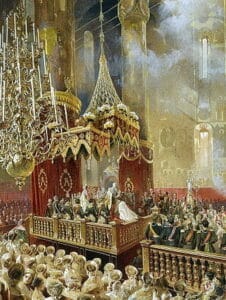
The coronation of Emperor Alexander II and Empress Maria
Emancipation of the Serfs
- Alexander embarked on a period of dramatic reforms, including an attempt to wean Russia off its reliance on the landed nobility dominating the poor, an endeavour to utilise Russia’s natural riches, and a reform of all parts of government.
- Alexander’s first year of reign was spent prosecuting the Crimean War and, with the surrender of Sevastopol, negotiating a peace treaty with his trusty adviser, Prince Alexander Gorchakov. Serfdom on private estates was abolished throughout the Russian Empire by the Emancipation Reform of 1861.
- Serfs obtained full citizenship rights, including the ability to marry without authorisation, possess property, and run a company. The act was Alexander II’s first and most significant liberal reform. The emancipation law was signed and published on 3 March 1861, six years after his ascension.
Additional Reforms
- Alexander II appointed Dmitry Milyutin as Minister of War to the Russian Military Forces from 1861 to 1881.
- Industry and trade became one of Alexander’s focuses of attention, constructing railways that would enhance Russia’s use of natural riches and boost its defence and attack capabilities.
- Military service was instituted on 1 January 1874. The reserve forces were extended and the military district system was introduced. Physical punishment in the Russian Military was prohibited. The majority of significant military changes were made as a result of the Crimean War’s dismal performance.
- The judicial reform of Alexander II paved the way for a new court system and the establishment of the order of legal proceedings. A new criminal code was introduced. Zemstvo was instituted with the establishment of local police under the Ministry of Internal Affairs of the Russian Federation and the implementation of tax laws. Taxes imposed on Jews were abolished and allowed them to work and live outside the western region of the Russian Empire. In 1867, Alexander II sold Alaska to the Americans for 7.2 million dollars because it was short of finances and they feared that it would lose against Great Britain during the wars.
Suppression of Separatist Movements
- From 1863-1864, a revolt took place between the Russian Government and the Polish-Lithuanian Commonwealth. It happened because Alexander II excluded the lands controlled by the Polish-Lithuanian Commonwealth from his liberal principles.
- In 1863, Alexander II declared martial law in Lithuania, which persisted for forty years. In 1876, he issued the ‘Ems Ukaz’ decree that forbids the use of the Ukrainian language in any printed text as well as other native languages like Polish, which was prohibited from being used both written and orally.
- Nikolay Alexeyevich Milyutin was appointed governor. He worked on the emancipation of the serfs and the establishment of the zemstvo.
Encouraging Finnish Nationalism
- The Diet of Finland was resumed, which paved the way for the creation of Finland’s own currency, the ‘Finnish markka’. Finland undertook a number of changes aimed at enhancing its autonomy inside the Russian Empire.
- The industrial revolution took place as Finland got its first railway on 31 January 1862. The transformation of Finnish into the national language created chances for a wider part of the Finnish nation. Because of this, Alexander was remembered as the ‘Good Tsar’ in Finland.
Foreign Affairs
- During the Crimean War, Russia and Austria were foes, and Austria maintained a hostile neutrality towards Russia. During the American Civil War (1861-1865), Russia backed the Union, mostly because they saw the US as a counterbalance to their geopolitical adversary, the United Kingdom of Great Britain and Ireland.
- After the creation of the Third French Republic, France abandoned its resistance to Russia, and Russia renounced the Black Sea articles of the 1856 Paris Treaty. During the Russo-Turkish War, Romania, Serbia, Montenegro and Bulgaria earned international recognition for their independence from the Ottoman Empire.
End of the Caucasian War
- Following the Russian Empire’s defeat of the Circassians in the Russo-Circassian War, the Circassian genocide occurred. Dmitry Milyutin originally proposed mass expulsions of Circassian indigenous in 1857. Before the end of the war in 1864, a huge deportation was initiated against the surviving inhabitants, essentially accomplished by 1867. Only a tiny minority agreed to surrender and relocate within Russia; those who refused were scattered, resettled, tortured or massacred in large numbers.
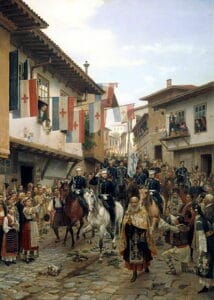
Russian general Iosif Gurko liberated Veliko Tarnovo
Liberation of Bulgaria
- From April to May 1876, the April Uprising took place between the Bulgarians and the Ottoman Empire.
- Emperor Alexander II began diplomatic arrangements with the other Great Powers in early 1877 to ensure their neutrality in the event of a conflict between Russia and the Ottomans. Such agreements were considered critical by Alexander II to avert a calamity akin to the Crimean War.
- The Russians were successful against the Turks, helped by the Romanian Army under its supreme commander, King Carol I.
- On 19 February 1878, the treaty of San Stefano was signed, paving the way for an independent Bulgarian state with Prince Alexander of Battenberg as their leader.
Assassination & Death
There were five failed assassination attempts during Alexander II’s reign:
- The first was in April 1866. Dimitry Vladimirovich Karakozov, a Russian activist, was executed for his attempt on Alexander II’s life. He was the first revolutionary to attempt the assassination of a tsar. Alexander II built numerous chapels and churches to celebrate his escape from death.
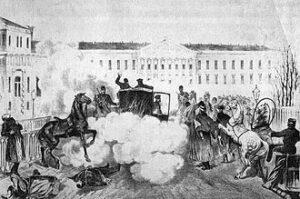
The explosion killed one of the Cossacks and wounded the driver. - Antoni Berezowski, a Polish nationalist, was also unsuccessful in killing Alexander II. During the International Exposition of 1867, Antoni fired at the waggon that Alexander was riding in with his two sons and Napoleon III, the first president of France.
- The third time happened on 20 April 1879 while Alexander II was walking in the Square of the Guards Staff. Alexander Konstantinovich Soloviev, a Russian revolutionary, fired at him five times but missed as Alexander was walking in a rapid zigzag pattern. He was hanged on 28 May 1879.
- In December 1879, a revolutionary political organisation named Narodnaya Volya also attempted to kill Alexander II by plotting an explosion on the train that the emperor was riding to Moscow, but they missed the train.
- The fifth attempt was on 5 February 1880. Stepan Khalturin, a Russian revolutionary and a member of the Narodnaya Volya, tried to kill Alexander by setting a time bomb at the Winter Palace, St Petersburg. But Alexander was not there. 11 people were killed and 30 were wounded.
- The revolutionary political organisation, Narodnaya Volya, was finally successful in killing Alexander II on 13 March 1881 in St Petersburg after two failed assassination attempts. Before his untimely death, he designated Count Mikhail Tarielovich Loris-Melikov as the leader of the Supreme Executive Commission to investigate and seize the Revolutionary Army.
- Alexander II was on his way to the riding academy when Nikolai Rysakov from the Narodnaya Volya threw a bomb that immediately exploded, killing one of Alexander II’s escorts and injuring the driver of the waggon they were riding.
- Alexander II escaped the location unscathed. They had no idea that another revolutionary member called Ignacy Hryniewiecki, a Polish member of the revolutionary, had planted a bomb near the emperor’s location, yelling, “It is too early to thank God.”
- Alexander was immediately rushed to the Winter Palace. Alexander was bleeding to death; his stomach had been ripped open, his face had been mangled and his legs had been severed. Members of the House of Romanov arrived in a hurry. His physician, Sergey Petrovich Botkin, one of the most famous doctors in Russia, said that he would not last more than fifteen minutes. On his deathbed, he was given the Commendation of the Dying and Communion. He died on 13 March 1881.
- After his death, his third child, Alexander III, assumed the throne. Anarchists were also motivated by the assassination of his father to propose ‘propaganda by deed’ – the deployment of a spectacular act of violence to ignite revolution. In 1881 a church located in Tampere was named after Alexander II.
Image Sources
- https://upload.wikimedia.org/wikipedia/commons/thumb/e/e9/Zar_Alexander_II_%28cropped%29.jpg/330px-Zar_Alexander_II_%28cropped%29.jpg
- https://upload.wikimedia.org/wikipedia/commons/thumb/7/7d/Cartetsar.JPG/330px-Cartetsar.JPG
- https://upload.wikimedia.org/wikipedia/commons/thumb/3/31/Mih%C3%A1ly_Zichy_-_Coronation_of_Alexander_II_%281857%2C_Hermitage%29_detail_01.jpg/330px-Mih%C3%A1ly_Zichy_-_Coronation_of_Alexander_II_%281857%2C_Hermitage%29_detail_01.jpg
- https://upload.wikimedia.org/wikipedia/commons/thumb/c/ce/Nikolai-dmitriev-orenburgsky-grand-prince-nikolai-nikolaevich-enters-trnovo-in-1877-1885.jpg/330px-Nikolai-dmitriev-orenburgsky-grand-prince-nikolai-nikolaevich-enters-trnovo-in-1877-1885.jpg
- https://upload.wikimedia.org/wikipedia/commons/thumb/6/60/Alexander_II_of_Russia%27s_murder_02.jpg/330px-Alexander_II_of_Russia%27s_murder_02.jpg

